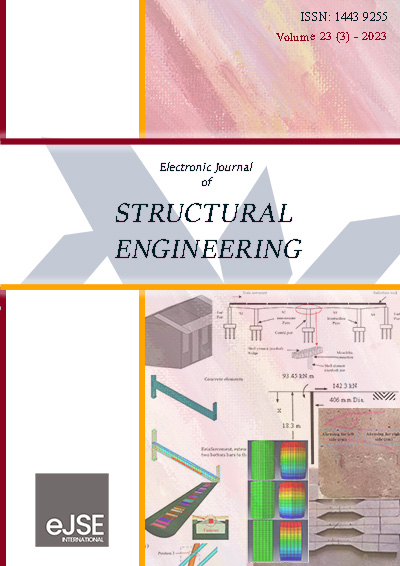Mechanical properties test of plant fiber reinforced cementitious composites
DOI:
https://doi.org/10.56748/ejse.234383Keywords:
Composite material, Matrix of cement, Plant fiber, Tensile test, Three-point bending testAbstract
In this paper, a new type of plant fiber-reinforced cementitious composite (PFRCC) is developed. Compared with ordinary cement-based materials, its toughness is greatly improved. To investigate the tensile and bending mechanical properties of PFRCC, four kinds of PFRCC panels with different thicknesses were developed, and the axial tensile test and bending test of the PFRCC panel were designed. The results show that with the increase in the thickness of the PFRCC panel, the bearing capacity increases gradually. The peak tensile strain is about 0.022 %, which is 1.47-2.2 times that of the matrix cement mortar. The average tensile strength is about 2.52 MPa, which is slightly higher than that of the matrix cement mortar. The bending failure load of the PFRCC panel increases with the increase in thickness, but its peak displacement decreases gradually. The bending strength of the PFRCC panel is about 13.5 MPa, which is 2.7 times that of the matrix cement mortar. It shows that the addition of plant fiber can not only increase the toughness of cement mortar but also improve its tensile and bending strength. The above research provides a theoretical basis for the application of PFRCC panels in practical engineerings such as permanent formwork of foundation beams and light-gauge steel stud concrete composite external wall panels.
Downloads
References
Abbass, W., Khan, M. I., & Mourad, S. (2018). Evaluation of mechanical properties of steel fiber reinforced concrete with different strengths of concrete. Construction and building materials, 168, 556-569. https://doi.org/10.1016/j.conbuildmat.2018.02.164 DOI: https://doi.org/10.1016/j.conbuildmat.2018.02.164
Balea, A., Fuente, E., Monte, M. C., Blanco, Á., & Negro, C. (2021). Fiber reinforced cement based composites. In Fiber Reinforced Composites (pp. 597-648). Woodhead Publishing. Teixeira, F. P., & de Andrade Silva, F. (2020). On the use of natural curauá reinforced cement based composites for structural applications. Cement and Concrete Composites, 114, 103775. https://doi.org/10.1016/j.cemconcomp.2020.103775 DOI: https://doi.org/10.1016/B978-0-12-821090-1.00019-3
Cao, M., & Li, L. (2018). New models for predicting workability and toughness of hybrid fiber reinforced cement-based composites. Construction and Building Materials, 176, 618-628. https://doi.org/10.1016/j.conbuildmat.2018.05.075 DOI: https://doi.org/10.1016/j.conbuildmat.2018.05.075
Congro, M., Roehl, D., & Mejia, C. (2021). Mesoscale computational modeling of the mechanical behavior of cement composite materials. Composite Structures, 257, 113137. https://doi.org/10.1016/j.compstruct.2020.113137 DOI: https://doi.org/10.1016/j.compstruct.2020.113137
Deng, Z. C., (2016). Flexural toughness and characterization method of hybrid fibers reinforced ultra-high performance concrete. Acta materiae compositate sinica 33(6): 1274-1280.
Deb, S., Mitra, N., Majumdar, S. B., & Roy, D. (2020). Rate of Hydration of Lignocellulosic Fiber-Reinforced Hydrated Cement. ACI Materials Journal, 117(6), 177-186. DOI: https://doi.org/10.14359/51726994
Ghadakpour, M., Choobbasti, A. J., & Kutanaei, S. S. (2020). Investigation of the Kenaf fiber hybrid length on the properties of the cement-treated sandy soil. Transportation Geotechnics, 22, 100301. https://doi.org/10.1016/j.trgeo.2019.100301 DOI: https://doi.org/10.1016/j.trgeo.2019.100301
Hasan, K. F., Horváth, P. G., & Alpár, T. (2022). Lignocellulosic fiber cement compatibility: a state of the art review. Journal of Natural Fibers, 19(13), 5409-5434.
https://doi.org/10.1080/15440478.2021.1875380 DOI: https://doi.org/10.1080/15440478.2021.1875380
Jamsawang, P., Suansomjeen, T., Sukontasukkul, P., Jongpradist, P., & Bergado, D. T. (2018). Comparative flexural performance of compacted cement-fiber-sand. Geotextiles and Geomembranes, 46(4), 414-425. https://doi.org/10.1016/j.geotexmem.2018.03.008 DOI: https://doi.org/10.1016/j.geotexmem.2018.03.008
Long, W., & Wang, Y. (2021). Effect of pine needle fibre reinforcement on the mechanical properties of concrete. Construction and Building Materials, 278, 122333. https://doi.org/10.1016/j.conbuildmat.2021.122333 DOI: https://doi.org/10.1016/j.conbuildmat.2021.122333
Mendes, R. F., Vilela, A. P., Farrapo, C. L., Mendes, J. F., Tonoli, G. H. D., & Mendes, L. M. (2017). Lignocellulosic residues in cement-bonded panels. In Sustainable and nonconventional construction materials using inorganic bonded fiber composites (pp. 3-16). Woodhead Publishing. https://doi.org/10.1016/B978-0-08-102001-2.00001-2 DOI: https://doi.org/10.1016/B978-0-08-102001-2.00001-2
Su, Y., Li, J., Wu, C., Wu, P., Tao, M., & Li, X. (2017). Mesoscale study of steel fibre-reinforced ultra-high performance concrete under static and dynamic loads. Materials & Design, 116, 340-351. https://doi.org/10.1016/j.matdes.2016.12.027 DOI: https://doi.org/10.1016/j.matdes.2016.12.027
Sargaphuti, M., Shah, S. P., & Vinson, K. D. (1993). Shrinkage cracking and durability characteristics of cellulose fiber reinforced concrete. Materials Journal, 90(4), 309-318. DOI: https://doi.org/10.14359/3879
Teixeira, F. P., & de Andrade Silva, F. (2020). On the use of natural curauá reinforced cement based composites for structural applications. Cement and Concrete Composites, 114, 103775. https://doi.org/10.1016/j.cemconcomp.2020.103775 DOI: https://doi.org/10.1016/j.cemconcomp.2020.103775
Wang, Z., Li, H., Jiang, Z., & Chen, Q. (2018). Effect of waste paper fiber on properties of cement-based mortar and relative mechanism. Journal of Wuhan University of Technology-Mater. Sci. Ed., 33(2), 419-426. DOI: https://doi.org/10.1007/s11595-018-1839-2
Zhang, T., Yin, Y., Gong, Y., & Wang, L. (2020). Mechanical properties of jute fiber‐reinforced high‐strength concrete. Structural Concrete, 21(2), 703-712. https://doi.org/10.1002/suco.201900012 DOI: https://doi.org/10.1002/suco.201900012
Downloads
Published
How to Cite
Issue
Section
License
Copyright (c) 2023 Junping He, Zongfeng He, Qing Cui, Xinyuan Wang, Xuansheng Cheng

This work is licensed under a Creative Commons Attribution 4.0 International License.
Funding data
-
National Natural Science Foundation of China
Grant numbers 51968045







